Solar eclipse of May 9, 1910
| Solar eclipse of May 9, 1910 | |
|---|---|
| Type of eclipse | |
| Nature | Total |
| Gamma | −0.9437 |
| Magnitude | 1.06 |
| Maximum eclipse | |
| Duration | 255 s (4 min 15 s) |
| Coordinates | 48°12′S 125°12′E / 48.2°S 125.2°E |
| Max. width of band | 594 km (369 mi) |
| Times (UTC) | |
| Greatest eclipse | 5:42:13 |
| References | |
| Saros | 117 (63 of 71) |
| Catalog # (SE5000) | 9304 |
A total solar eclipse occurred at the Moon's ascending node of orbit on Monday, May 9, 1910,[1][2][3][4] with a magnitude of 1.06. A solar eclipse occurs when the Moon passes between Earth and the Sun, thereby totally or partly obscuring the image of the Sun for a viewer on Earth. A total solar eclipse occurs when the Moon's apparent diameter is larger than the Sun's, blocking all direct sunlight, turning day into darkness. Totality occurs in a narrow path across Earth's surface, with the partial solar eclipse visible over a surrounding region thousands of kilometres wide. Occurring about 10 hours after perigee (on May 8, 1910, at 19:20 UTC), the Moon's apparent diameter was larger.[5]
Totality was visible from part of Wilkes Land in Antarctica and Tasmania in Australia. A partial eclipse was visible for parts of Antarctica, Australia, and Southeast Asia.
Observations
Except for Antarctica, the only land covered by the path of totality was the central and southern parts of Tasmania. The eclipse occurred in winter when Tasmania is usually rainy with bad observation conditions. However, British pioneer aviator Francis McClean still organized and led a team to Port Davey on the southwestern coast of Tasmania, but in the end failed to make observations due to rainy weather. In addition, observations on Bruny Island, southeast of Tasmania also failed due to the weather. Zeehan and Strahan on the west coast of Tasmania were clear during the partial phase, but had poor weather during the total phase. Queenstown, located slightly inland, was one of the few places where the entire process of the eclipse was seen. Some observers took images of the corona there.[6][7]
Eclipse details
Shown below are two tables displaying details about this particular solar eclipse. The first table outlines times at which the moon's penumbra or umbra attains the specific parameter, and the second table describes various other parameters pertaining to this eclipse.[8]
| Event | Time (UTC) |
|---|---|
| First Penumbral External Contact | 1910 May 09 at 03:38:20.0 UTC |
| Equatorial Conjunction | 1910 May 09 at 05:03:20.8 UTC |
| First Umbral External Contact | 1910 May 09 at 05:04:55.4 UTC |
| First Central Line | 1910 May 09 at 05:09:08.5 UTC |
| First Umbral Internal Contact | 1910 May 09 at 05:13:54.4 UTC |
| Ecliptic Conjunction | 1910 May 09 at 05:32:47.7 UTC |
| Greatest Eclipse | 1910 May 09 at 05:42:12.6 UTC |
| Greatest Duration | 1910 May 09 at 05:42:47.5 UTC |
| Last Umbral Internal Contact | 1910 May 09 at 06:10:56.2 UTC |
| Last Central Line | 1910 May 09 at 06:15:41.3 UTC |
| Last Umbral External Contact | 1910 May 09 at 06:19:53.6 UTC |
| Last Penumbral External Contact | 1910 May 09 at 07:46:22.1 UTC |
| Parameter | Value |
|---|---|
| Eclipse Magnitude | 1.06000 |
| Eclipse Obscuration | 1.12360 |
| Gamma | –0.94372 |
| Sun Right Ascension | 03h01m00.1s |
| Sun Declination | +17°07'25.6" |
| Sun Semi-Diameter | 15'50.4" |
| Sun Equatorial Horizontal Parallax | 08.7" |
| Moon Right Ascension | 03h02m29.5s |
| Moon Declination | +16°13'49.4" |
| Moon Semi-Diameter | 16'42.2" |
| Moon Equatorial Horizontal Parallax | 1°01'18.1" |
| ΔT | 10.8 s |
Eclipse season
This eclipse is part of an eclipse season, a period, roughly every six months, when eclipses occur. Only two (or occasionally three) eclipse seasons occur each year, and each season lasts about 35 days and repeats just short of six months (173 days) later; thus two full eclipse seasons always occur each year. Either two or three eclipses happen each eclipse season. In the sequence below, each eclipse is separated by a fortnight. The first and last eclipse in this sequence is separated by one synodic month.
| May 9 Ascending node (new moon) |
May 24 Descending node (full moon) |
|---|---|
 |

|
| Total solar eclipse Solar Saros 117 |
Total lunar eclipse Lunar Saros 129 |
Related eclipses
Eclipses in 1910
- A total solar eclipse on May 9.
- A total lunar eclipse on May 24.
- A partial solar eclipse on November 2.
- A total lunar eclipse on November 17.
Metonic
- Preceded by: Solar eclipse of July 21, 1906
- Followed by: Solar eclipse of February 25, 1914
Tzolkinex
- Preceded by: Solar eclipse of March 29, 1903
- Followed by: Solar eclipse of June 19, 1917
Half-Saros
- Preceded by: Lunar eclipse of May 3, 1901
- Followed by: Lunar eclipse of May 15, 1919
Tritos
- Preceded by: Solar eclipse of June 8, 1899
- Followed by: Solar eclipse of April 8, 1921
Solar Saros 117
- Preceded by: Solar eclipse of April 26, 1892
- Followed by: Solar eclipse of May 19, 1928
Inex
- Preceded by: Solar eclipse of May 27, 1881
- Followed by: Solar eclipse of April 19, 1939
Triad
- Preceded by: Solar eclipse of July 8, 1823
- Followed by: Solar eclipse of March 9, 1997
Solar eclipses of 1910–1913
This eclipse is a member of a semester series. An eclipse in a semester series of solar eclipses repeats approximately every 177 days and 4 hours (a semester) at alternating nodes of the Moon's orbit.[9]
The partial solar eclipse on August 31, 1913 occurs in the next lunar year eclipse set.
| Solar eclipse series sets from 1910 to 1913 | ||||||
|---|---|---|---|---|---|---|
| Ascending node | Descending node | |||||
| Saros | Map | Gamma | Saros | Map | Gamma | |
| 117 | May 9, 1910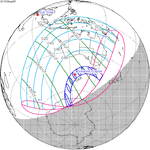 Total |
−0.9437 | 122 | November 2, 1910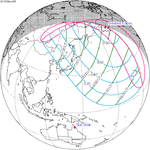 Partial |
1.0603 | |
| 127 | April 28, 1911 Total |
−0.2294 | 132 | October 22, 1911 Annular |
0.3224 | |
| 137 | April 17, 1912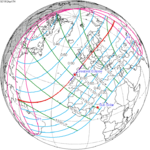 Hybrid |
0.528 | 142 | October 10, 1912 Total |
−0.4149 | |
| 147 | April 6, 1913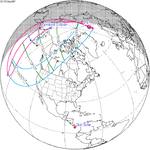 Partial |
1.3147 | 152 | September 30, 1913 Partial |
−1.1005 | |
Saros 117
This eclipse is a part of Saros series 117, repeating every 18 years, 11 days, and containing 71 events. The series started with a partial solar eclipse on June 24, 792 AD. It contains annular eclipses from September 18, 936 AD through May 14, 1333; hybrid eclipses from May 25, 1351 through July 8, 1423; and total eclipses from July 18, 1441 through May 19, 1928. The series ends at member 71 as a partial eclipse on August 3, 2054. Its eclipses are tabulated in three columns; every third eclipse in the same column is one exeligmos apart, so they all cast shadows over approximately the same parts of the Earth.
The longest duration of annularity was produced by member 16 at 9 minutes, 26 seconds on December 3, 1062, and the longest duration of totality was produced by member 62 at 4 minutes, 19 seconds on April 26, 1892. All eclipses in this series occur at the Moon’s ascending node of orbit.[10]
| Series members 57–71 occur between 1801 and 2054: | ||
|---|---|---|
| 57 | 58 | 59 |
 March 4, 1802 |
 March 14, 1820 |
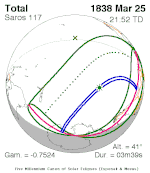 March 25, 1838 |
| 60 | 61 | 62 |
 April 5, 1856 |
 April 16, 1874 |
 April 26, 1892 |
| 63 | 64 | 65 |
 May 9, 1910 |
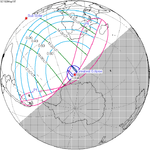 May 19, 1928 |
 May 30, 1946 |
| 66 | 67 | 68 |
 June 10, 1964 |
 June 21, 1982 |
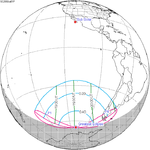 July 1, 2000 |
| 69 | 70 | 71 |
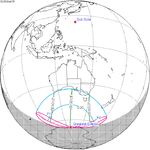 July 13, 2018 |
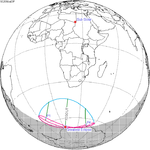 July 23, 2036 |
 August 3, 2054 |
Metonic series
The metonic series repeats eclipses every 19 years (6939.69 days), lasting about 5 cycles. Eclipses occur in nearly the same calendar date. In addition, the octon subseries repeats 1/5 of that or every 3.8 years (1387.94 days). All eclipses in this table occur at the Moon's ascending node.
| 22 eclipse events between December 13, 1898 and July 20, 1982 | ||||
|---|---|---|---|---|
| December 13–14 | October 1–2 | July 20–21 | May 9 | February 24–25 |
| 111 | 113 | 115 | 117 | 119 |
 December 13, 1898 |
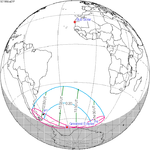 July 21, 1906 |
 May 9, 1910 |
 February 25, 1914 | |
| 121 | 123 | 125 | 127 | 129 |
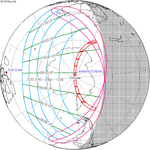 December 14, 1917 |
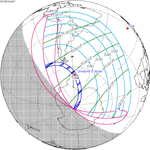 October 1, 1921 |
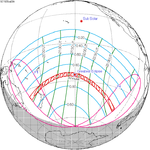 July 20, 1925 |
 May 9, 1929 |
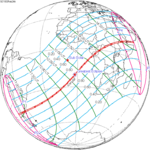 February 24, 1933 |
| 131 | 133 | 135 | 137 | 139 |
 December 13, 1936 |
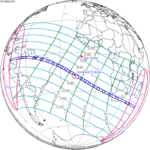 October 1, 1940 |
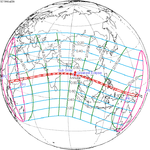 July 20, 1944 |
 May 9, 1948 |
 February 25, 1952 |
| 141 | 143 | 145 | 147 | 149 |
 December 14, 1955 |
 October 2, 1959 |
 July 20, 1963 |
 May 9, 1967 |
 February 25, 1971 |
| 151 | 153 | 155 | ||
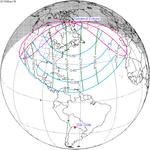 December 13, 1974 |
 October 2, 1978 |
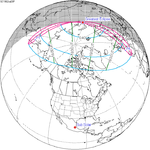 July 20, 1982 | ||
Tritos series
This eclipse is a part of a tritos cycle, repeating at alternating nodes every 135 synodic months (≈ 3986.63 days, or 11 years minus 1 month). Their appearance and longitude are irregular due to a lack of synchronization with the anomalistic month (period of perigee), but groupings of 3 tritos cycles (≈ 33 years minus 3 months) come close (≈ 434.044 anomalistic months), so eclipses are similar in these groupings.
| Series members between 1801 and 2200 | ||||
|---|---|---|---|---|
 March 14, 1801 (Saros 107) |
 February 12, 1812 (Saros 108) |
 January 12, 1823 (Saros 109) |
 November 10, 1844 (Saros 111) | |
 August 9, 1877 (Saros 114) |
 July 9, 1888 (Saros 115) |
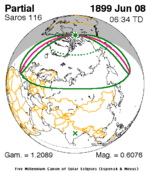 June 8, 1899 (Saros 116) | ||
 May 9, 1910 (Saros 117) |
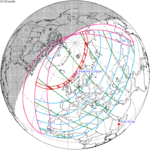 April 8, 1921 (Saros 118) |
 March 7, 1932 (Saros 119) |
 February 4, 1943 (Saros 120) |
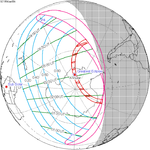 January 5, 1954 (Saros 121) |
 December 4, 1964 (Saros 122) |
 November 3, 1975 (Saros 123) |
 October 3, 1986 (Saros 124) |
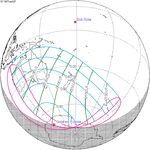 September 2, 1997 (Saros 125) |
 August 1, 2008 (Saros 126) |
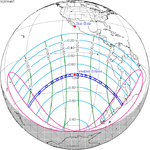 July 2, 2019 (Saros 127) |
 June 1, 2030 (Saros 128) |
 April 30, 2041 (Saros 129) |
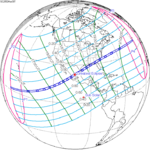 March 30, 2052 (Saros 130) |
 February 28, 2063 (Saros 131) |
 January 27, 2074 (Saros 132) |
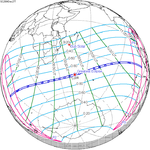 December 27, 2084 (Saros 133) |
 November 27, 2095 (Saros 134) |
 October 26, 2106 (Saros 135) |
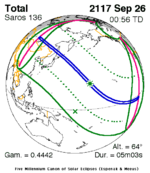 September 26, 2117 (Saros 136) |
 August 25, 2128 (Saros 137) |
 July 25, 2139 (Saros 138) |
 June 25, 2150 (Saros 139) |
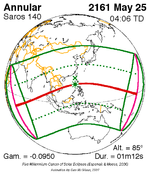 May 25, 2161 (Saros 140) |
 April 23, 2172 (Saros 141) |
 March 23, 2183 (Saros 142) |
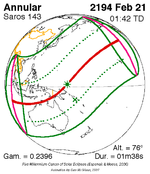 February 21, 2194 (Saros 143) | |||
Inex series
This eclipse is a part of the long period inex cycle, repeating at alternating nodes, every 358 synodic months (≈ 10,571.95 days, or 29 years minus 20 days). Their appearance and longitude are irregular due to a lack of synchronization with the anomalistic month (period of perigee). However, groupings of 3 inex cycles (≈ 87 years minus 2 months) comes close (≈ 1,151.02 anomalistic months), so eclipses are similar in these groupings.
| Series members between 1801 and 2200 | ||
|---|---|---|
 July 8, 1823 (Saros 114) |
 June 17, 1852 (Saros 115) |
 May 27, 1881 (Saros 116) |
 May 9, 1910 (Saros 117) |
 April 19, 1939 (Saros 118) |
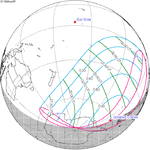 March 28, 1968 (Saros 119) |
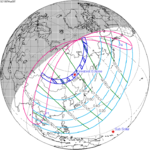 March 9, 1997 (Saros 120) |
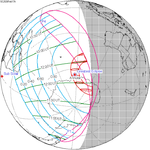 February 17, 2026 (Saros 121) |
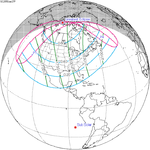 January 27, 2055 (Saros 122) |
 January 7, 2084 (Saros 123) |
 December 19, 2112 (Saros 124) |
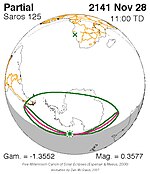 November 28, 2141 (Saros 125) |
 November 8, 2170 (Saros 126) |
 October 19, 2199 (Saros 127) |
|
References
- ^ "May 9, 1910 Total Solar Eclipse". timeanddate. Retrieved 31 July 2024.
- ^ "PARTIAL ECLIPSE OF THE SUN. IMPERFECT OBSERVATION IN SYDNEY". The Sun. Sydney, New South Wales, Australia. 1910-05-09. p. 5. Retrieved 2023-11-03 – via Newspapers.com.
- ^ "ECLIPSE OF THE SUN. VISIBLE AT BROKEN HILL TO-DAY". The Barrier Miner. Broken Hill, New South Wales, Australia. 1910-05-09. p. 5. Retrieved 2023-11-03 – via Newspapers.com.
- ^ "The solar eclipse". The Daily Telegraph. Sydney, New South Wales, Australia. 1910-05-10. p. 10. Retrieved 2023-11-03 – via Newspapers.com.
- ^ "Moon Distances for London, United Kingdom, England". timeanddate. Retrieved 31 July 2024.
- ^ F. K. McClean; et al. (May 1910). "Report of the Solar Eclipse Expedition to Port Davey, Tasmania, May, 1910" (PDF). Archived from the original (PDF) on 21 October 2020.
- ^ Lockyer, Sir Norman; Group, Nature Publishing; Gateway, UM-Medsearch (23 June 1910). "THE TOTAL SOLAR ECLIPSE OF May 9, 1910". Nature. 83 (2121): 494–495. doi:10.1038/083494a0. Archived from the original on 1 January 2014.
{{cite journal}}:|last2=has generic name (help) - ^ "Annular Solar Eclipse of 1910 May 09". EclipseWise.com. Retrieved 31 July 2024.
- ^ van Gent, R.H. "Solar- and Lunar-Eclipse Predictions from Antiquity to the Present". A Catalogue of Eclipse Cycles. Utrecht University. Retrieved 6 October 2018.
- ^ "NASA - Catalog of Solar Eclipses of Saros 117". eclipse.gsfc.nasa.gov.
- Earth visibility chart and eclipse statistics Eclipse Predictions by Fred Espenak, NASA/GSFC




